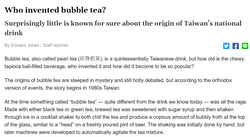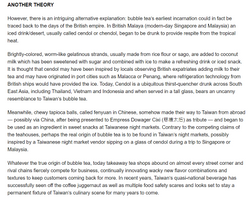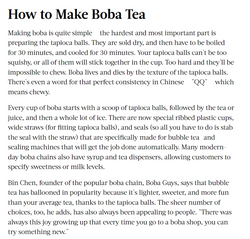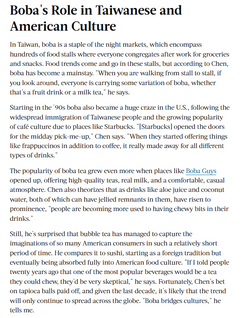Jan 30, 2023
Boba Tea
1
Article/s: https://fanaledrinks.com/blogs/blog/the-history-of-boba-tea#:~:text=This%20sweet%20and%20refreshing%20beverage,for%20breakfast%20or%20a%20snack.
https://www.foodandwine.com/tea/bubble-tea-taiwanese-street-drink-turned-american-addiction
https://www.bubbleteasupply.com/bubble-tea-history
Introduction
2
Boba tea, also known as pearl milk tea or bubble tea, is a refreshing drink made with black or green tea, milk, and tapioca pearls. The balls or pearls are what give the drink its name, as they are meant to be sucked on like bubbles. Boba tea has become increasingly popular in the United States in recent years and can be found at most coffee shops and Asian restaurants. Let's take a closer look at the history of boba tea and find out why it's such a popular beverage.
3
Maybe it's the chewy, craveable texture of the tapioca balls, the creaminess of the milky tea, or the simple satisfaction of popping the straw into the sealed plastic top — people can't get enough of bubble tea (a.k.a. boba).
Bubble Tea is one of the few tea preparations that has become a full-blown sensation not only in its country of origin, Taiwan, but abroad as well. Today, the U.S. is dotted with bubble tea chains. But who on earth came up with the idea of putting tapioca balls in tea?
4
Elementary school children would look forward to buying a cup of refreshing tea after a long, hard day of work and play. Tea stands were set up in front of the schools and would compete for business with the best selling tea. One concession owner became popular with her tea when she started adding different fruit flavoring to her tea. Because of the sweet and cool taste, children loved the taste. Soon, other concessions heard about the "unique" and popular tea, so they started to add flavoring to their teas. When adding flavor, the tea and flavoring needed to be shaken well for a good all around taste. This formed bubbles in the drink, which came to be known as "Bubble Tea."
5
HISTORY
The origins of boba tea are unclear, but it is thought to have originated in Taiwan in the 1980s. This sweet and refreshing beverage can be traced back to Taichung City in Taiwan in the 1980s. It was first created by Liu Han Chieh, who combined milk tea with black tapioca balls. The drink became popular with students, who would buy it from street vendors for breakfast or a snack.
6
Another claim for the invention of bubble tea comes from the owner of the Hanlin Tea Room of Tainan City in Taiwan, Tu Tsong-he was inspired to create bubble tea when he saw white tapioca balls for sale in 1986. His idea was to create something new that would be popular among customers who were bored of drinking plain old boring teas.







14
Is Boba Vegan
Have you ever sipped on a refreshing cup of bubble tea and wondered what the health repercussions are? Often ordered together, toppings are a nice treat to the usual consumer who orders their milk or fruit tea based beverage. Various toppings can include boba pearls, popping boba, lychee jelly, grass jelly, and many other fun options.
Boba pearls, deemed the most popular and widely ordered all around the world, can raise a few questions whether what’s inside of those little pearls or whether they're appropriate for individuals who are vegan. To start off, boba pearls are rooted from starch of the cassava plant and contain tapioca which is all vegan. Boba pearls are then mixed with simple syrup to add its signature sweetness to your tea.
15
Other popular toppings often discussed are grass jelly and popping boba. Popularly eaten in East and Southeast Asia, grass jelly comes from the Chinese mesona plant (Platostoma palustre) and contains no fat, minerals, or vitamins. This may seem like a very nutritious topping, but you may wonder if it includes any benefits to your diet.
Believe it or not, grass jelly contains antioxidants and includes antibacterial properties, which can be very beneficial to one’s digestion. The rich fiber content contained in grass jelly can help regulate and ease stomach pain. Grass jelly which has a jelly-type texture can often be confused with the similar taste of gelatin, which derives from the bone, skin, & ligaments of dead animals. Rest assured, grass jelly does not include any gelatin and is also fully vegan.
16
Popping boba, which instantly became a hit in the early 2000’s when the frozen yogurt craze was at its peak. These small balls of ‘boba’ are actually somewhat different from the usual tapioca boba many are familiar with. This fun and delicious topping is made from seaweed extract. It creates a thin layer of gelatinous coating and different chewing experience. Popping boba, which is often filled with fruit juice and bursts into your mouth when bitten has given fans of boba tea a fruitful experience throughout the years of its existence. Main ingredients used are water, sugar, and fruit juices in a variety of flavors including; mango, strawberry, passion fruit, green apple, & more.
17
Coconut jelly, which is also a very popular topping within the milk tea industry, has set the standard for many various shapes and variations of this dessert. They are white & translucent, and often very chewy in texture with a sleek and sweet milky taste. Similar to grass jelly, coconut jelly also carries a lot of health benefits when eaten. Coconut jelly carries antioxidants and fiber which is very nutritional and useful to aid in digestion along with normalizing blood glucose levels and relieving constipation.
Other health benefits that coconut jelly contains include a significant amount of protein needed for building muscle. Coconut pulp also when matured is very beneficial as it lowers high cholesterol and protects the heart from cardiovascular diseases. It’s a great snack whether you’re drinking it from your tea or enjoying it as a light snack, it can significantly help with weight loss, regulate high blood sugar, and reduce inflammation.
18
Other questions may arise when drinking your milk or fruit tea if it’s vegan as well. The simple answer to that is it solely depends on how the boba drink is made. Traditional milk tea is often prepared with cow’s milk which is not vegan, however many boba shops nowadays do carry non-dairy alternatives like almond milk or soy milk to make your favorite drink. For fruit teas, most are consistently vegan as they don’t use any products harmful to animals. Most fruit based teas mainly contain flavored tea and syrup to achieve its flavorful taste.
However, boba pearls can vary depending on whether they are vegan or not. This is solely based on how the boba pearls are prepared from the establishment/shop. Typically boba pearls are prepared using simple syrup, but often it is mixed with honey to give its sweetness that many recognize. Honey, however, is not vegan so next time when ordering your boba drink, you may ask your store to see if it’s served with honey.
19
There are a lot of different factors and variations when it comes to having vegan options when consuming boba milk tea. One of the most important being that if the drink contains milk or a non-dairy alternatives like almond milk or soy milk. Lastly, the pearls themselves can be prepared differently. If honey was used, it’s best to see if there are any vegan options. Although, if you’re ordering a fruit tea with lychee jelly, all rest assured your drink is vegan!
By undefined
19 notes ・ 4 views
English
Elementary